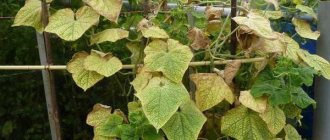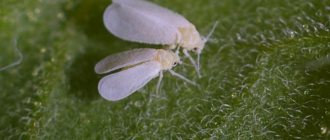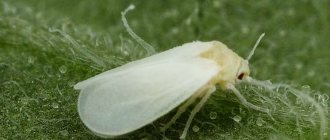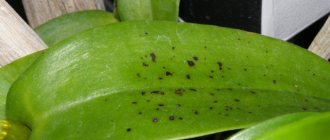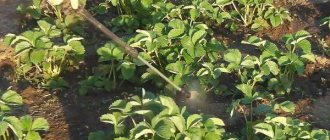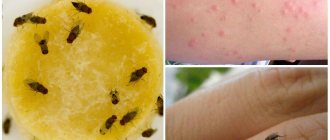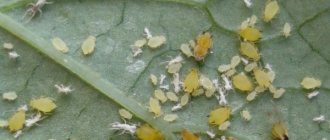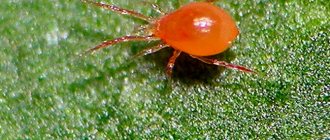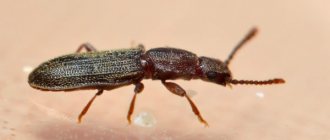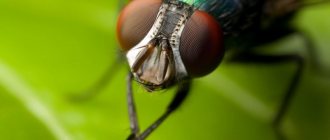Voracious white midges on the leaves of planted cucumbers will destroy most of the crop if measures are not taken. It is not difficult to determine what kind of dangerous pest has settled on the site. The insect has two pairs of wings, the surface of which is covered with a pale yellow coating. The pest's favorite habitat is the inside of the leaf. The reasons for the appearance of the insect are due to the mistakes of the gardener who does not monitor the conditions in which the seedlings are kept. Effective methods of combating it are related to the elimination of such shortcomings.
What factors provoke the appearance of a pest?
High temperature and high humidity levels are two negative factors that adversely affect crispy vegetables. It is a mistake to think that an insect lives only in greenhouse conditions, where a closed ecosystem exists. In open ground, white midges can make themselves felt. The adult individual prefers the juice of the plant - its favorite food. The more actively the pest satisfies hunger, the faster the bush dies.
You may be interested in:
Fighting spider mites in a greenhouse on cucumbers If you are interested in the question of how to get rid of spider mites on cucumbers in a greenhouse, you should familiarize yourself with folk...Read more...
The second problem caused by the activity of the parasite is the secretion or dew it secretes. A pathogenic fungus multiplies in it. After 24-30 hours, the cucumber seedlings become sick. Productivity decreases. The third problem is that midges need leaves to lay eggs. They are located along the inside. Less often, the masonry is noticeable on the stem or at the base.
On a note!
Not only heat and high humidity levels can provoke the appearance of a parasite in an area. White-winged midge eggs can be introduced if you take untested planting material. The source of problems will be the neighbor's garden, the owner of which does not engage in prevention.
White midge or greenhouse whitefly
Whitefly
Another dangerous pest is the greenhouse whitefly. This is a small insect with white wings and a body covered with a white waxy coating.
The whitefly settles on the back of the leaves.
Despite its small size, this pest quickly destroys crops.
Just like aphids, they feed on plant sap.
In addition to this, the whitefly secretes a substance containing sooty fungus. The plant becomes sick, the leaves and lashes quickly darken and die.
It is easier to protect yourself from an insect than to remove it. In order to avoid the appearance of the pest in cucumbers, before planting cucumbers, it is necessary to stretch gauze over the greenhouse windows. The doorway should also be covered with fabric.
As in the previous case, weeds can become a source of unwanted guests. They need to be uprooted and thrown away. Special pest traps work well. Cucumbers can be treated with the two percent Actofit preparation. Three sprays per season are enough.
Signs of winged pest activity
Early detection of midges minimizes possible harm to seedlings. The first and obvious symptom is white dots on the leaf blade. If only eggs have settled on the bush, you may notice blurry white spots. Other symptoms:
- the appearance of characteristic powdery mildew secreted by insects on the edges of leaves;
- a sharp decrease in cucumber mass;
- leaves curl;
- signs of chlorosis disease appear, the carrier of which is midges;
- buds dry out quickly;
- ovaries with buds fall off.
You should be wary of a swarm of insects or several individuals. The pest is voracious. For him, leaves are a delicacy that he is ready to consume in huge quantities. Within 2-4 days from the beginning of the active phase, the leaf blades are covered with a sticky mass. You can determine it by touch. Once the midge becomes an adult, its body is covered with a sticky substance. It protects the insect from negative environmental factors. It is destructive for seedlings. Traces of burns are visible on the leaf plates.
Chemical control agents
The use of specialized “chemistry” is permitted in open ground and in greenhouses in limited quantities. Violating the recommended proportions indicated on the packaging will cause more harm than midges. The drug "Iskra Bio" is developed on the basis of components that have minimal effect on the cucumber bush:
- it is allowed to process seedlings at the fruiting stage;
- safe for farm animals;
- safe for humans, but Iskra Bio can only be used with protective gloves;
- 72 hours after treatment, the crop does not contain any components of the drug;
- Application is carried out during the day at a temperature of + 25 C + 30 C.
Dissolve 40 ml of Iskra Bio in 5 liters of clean warm water. Treatment is carried out 2 times a week for 1 month. If the symptoms have disappeared, then the application of the biologically active substance is continued for another 3-4 days. Solutions based on the drug "Aktara" are prepared by owners of large plots or commercial farms.
4 g of substance are dissolved in 10 liters of water. Spraying is carried out once every 5 days for 3 weeks. Another means of combat is Mospilan. A broad-spectrum drug is used at the initial stage of pest activity. Take 1 substance per 2 liters of water. Consumption rate – 200 ml for every 1 m².
You may be interested in:
Aphids on cucumbers: causes of appearance and methods of control Aphids are a dangerous harmful insect that lives in symbiosis with ants.
The presence of the latter on the site is one of the main...Read more...
How to rid garden beds of pests
It is necessary to take urgent action to save bushes from a harmful insect at the first symptoms of damage. The further the process goes, the more difficult it will be to do this. Parasites can be quickly destroyed only with modern insecticides. Such drugs as “Karbofos”, “Bud”, “Verticillin”, “Iskra” are suitable for this purpose, and in advanced cases it is worth using “Aktara” or “Detis”. But the use of poison on vegetables is fraught with negative consequences in the form of deterioration of health. Some toxic elements accumulate in the soil.
Harvesting from such an area is unsafe. Veterinary products based on fipronil – “Bars”, etc. – are considered less toxic. If you don’t want to use chemical solutions in your garden beds, you can trust traditional methods. Laundry soap, garlic, tobacco, etc. give a good effect. They are diluted in the required proportions and sprayed on the plantings. You can apply the emulsion with a sponge. The soap is first crushed and then dissolved in warm water. This technique is especially good in cases where the whiteflies have not yet had time to lay eggs. To prepare garlic tincture, take a couple of cloves of garlic per 1 liter of boiled water. The resulting mixture is kept for a day in a dark place, filtered and applied to the leaves. This method requires at least three treatments.
Folk methods of struggle
Botanists urge not to rush to conclusions. On the one hand, traditional methods of pest control have no side effects. Repeated treatments will not lead to the accumulation of toxins in the fruits. On the other hand, the effectiveness of traditional methods leaves much to be desired. At the initial stage of infection, there is a high chance of ridding the leaves of midges.
Important!
If whitefly activity is noticeable for more than 5-7 days, it is worth using “chemistry”.
The classic folk “fighter” against midges is red pepper, on the basis of which a tincture is prepared. Take 200 g of tobacco dust and 10 liters of water. Both components are mixed. Further procedure:
- add 30 g capsicum;
- give 24 hours for the mixture to infuse;
- add 1 tablespoon of laundry soap;
- add 3 tablespoons of tree resin;
- to stir thoroughly;
- Spraying is carried out once every 7 days for 3 weeks.
The second recommendation on how to deal with the pest yourself involves the use of traps. Take a piece of light-colored cardboard, on top of which decorative non-drying glue is applied. If you don't have it, you can use castor oil. Similar traps are placed among cucumber plantings. In the morning and evening, each bush is gently shaken. The midges fly up and land on the surface of the cardboard. Garlic solution is a more radical remedy, according to folk recipes:
- 2 cloves of garlic;
- grind them to a pulp;
- add garlic to a bucket of water (1 l);
- the solution is left in a dark place for a day;
- after 24 hours, the mixture is filtered;
- spraying of plantings is carried out 3 times during the week;
- after a 1-week break, spraying is repeated.
Folk remedies cannot be perceived as a panacea. If within 5-6 days of use the number of midges has not decreased, you need to switch to “chemistry”.
On a note!
You cannot use the same folk remedies more than 4 times during the season. Midges develop immunity. Further processing becomes ineffective.
The main signs of the appearance of black midges
One of the signs that tomatoes have been attacked by aphids (small black midges) is wilting of the leaves. Many people decide that the plant does not have enough moisture and water it abundantly. If the pests appeared a long time ago, then dark spots appear on the stem, which over time turn into a dry brown crust.
Tomato leaves wither and curl
This signals that the plant needs to be carefully inspected. Most often, a small pest with wings can be found in the lower part or axils of leaves. With an inexperienced eye, aphids may not be immediately visible, so it is better to inspect during the day when the sun is shining brightly.
If aphids are not found on one of the wilting tomatoes, inspect all the plants. Even without seeing pests, it is better to carry out preventive treatment, this will ensure that undetected individuals will disappear.
Another sign of black midges appearing on tomatoes is a large number of ant trails near the garden bed. Ants protect aphids, because the sweet liquid secreted by pests is the best food for them.
Hot pepper for infusion against aphids
- 200 g garlic;
- 50 grams of dry mustard;
- 20 grams of red hot pepper.
First, place the chopped garlic in a bucket of water and leave to stand for several hours. Stir occasionally. Just before use, add hot pepper and mustard. Spray the tomatoes twice - in the evening and in the morning.
If time permits, you can use onion peels for the same purpose. Boil it for half an hour in water. The solution must be very concentrated; you will need a lot of husks - about 300 grams per bucket.
White midges
The fight against whiteflies is most often carried out with the help of dill bushes planted between the rows of tomatoes. White midges are very afraid of the smell of the umbrella crop and their appearance on tomatoes is extremely rare.
You can try to get rid of white midges using garlic infusion. Infuse 300 grams of crushed garlic in ten liters of water for a week. After this, strain and generously spray the tomato bushes.
When listing insects from the category of pests of cucumber seedlings, it is worth mentioning the cucumber mosquito. Most often it appears on plants affected by any diseases. Insects pose a serious threat to the roots and stems of cucumbers. Not only adult mosquitoes are considered dangerous, but also mosquito larvae that live in humus or manure.
In this case, the protection of cucumbers will be based on the use of spraying preparations. One of the proven options is Iskra. The solution is prepared according to the instructions from one tablet diluted in 10 liters of water. This amount of solution is enough to treat up to 100 m2 of land.
Additionally, it will be necessary to thermally sterilize the soil.
Preventive actions
White midge pests appear on cucumbers under conditions of a consistently unfavorable temperature background for cucumbers. It is enough to install a thermometer in the greenhouse to not give parasites a chance. The nighttime temperature background is kept at + 17 C + 20 C, and the daytime temperature is not higher than + 28 C. The second detail is the arrangement of ventilation. In a greenhouse, the system ensures a uniform flow of air, but not a draft. The third detail is regular preventive disinfection of the soil. The drugs "Karbofos" or "Decis" are used once every 4 weeks, according to the instructions. Other recommendations:
- Punctuality – sowing deadlines must be observed. It all depends on the characteristics of the selected cucumber variety.
- Quality - seed material is purchased in the store. You cannot plant it without first disinfecting it in a solution of potassium permanganate.
- Humidity level - before each watering, check the water content in the soil. If it is wet, then you should wait. Too much water, as well as not enough water, will weaken the plant.
- Clean – Weeds, fallen leaves and other waste are removed immediately. You cannot leave biological residues on the garden bed - a breeding ground for the pest.
The harvest ends with a general cleaning of the greenhouse. If cucumbers were grown in open ground, then dig up the soil. The last recommendation for what a gardener should do is to till the soil. Use copper or iron sulfate.
The whitefly midge is a pest that eats the leaves of cucumber seedlings. The danger is posed by adults and young animals. The first symptoms are noticeable immediately after infection. The characteristic white spots and dots on the leaves should alert the gardener. At the initial stage of infection, you can get by with folk remedies. From the moment the insect’s active phase begins, “chemistry” comes into play.
What to do if midges appear on cucumbers?
The main thing to remember is that there is no single remedy for all types of midges. This means that for each type of midge that appears, you will have to select specific control methods. You should not waste time and let the situation take its course. At the first appearance of midges, measures must be taken to preserve the plants. In some cases, you can only get by with folk remedies, and sometimes it is simply necessary to use various chemicals. Let's take a closer look at both.
